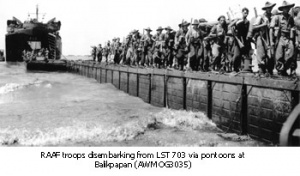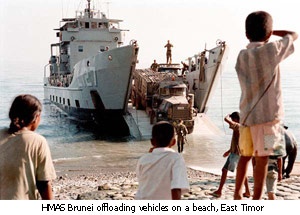Borneo 1945 - An Amphibious Success Story
Sixty years ago Australian forces successfully led the Allied liberation of Borneo, the world's third largest island, from Japanese occupation in the OBOE series of operations. These operations culminated in OBOE TWO, the amphibious assault on Balikpapan which was not only the last large scale Allied operation of World War II but remains Australia's largest ever amphibious assault. As the culmination of the RAN's participation in over 20 South West Pacific amphibious landings during World War II, the Balikpapan invasion demonstrated the high level of expertise in amphibious operations that had been achieved, as well as the degree to which joint and combined operations had developed during almost six years of war.
With rich oil resources and functional aerodromes, the strategic worth of Borneo was debated at the highest levels. Borneo's position at the base of the South China Sea meant that it shared coastal waters with Indo-China, Malaya, Sumatra, Java, Celebes and the Philippines. The US Joint Chiefs of Staff proposed an invasion of Borneo in order to secure oil and rubber supplies, and to interdict Japanese communications with South East Asia. Borneo was also seen as a step towards an advance on Java.
Controversy surrounds the Borneo campaign. For example, the British Chiefs of Staff did not agree with the need for an advanced fleet base in Brunei Bay, and General Thomas A. Blamey, the Australian Commander in Chief, saw no justification for attacking Balikpapan.[1] At the time it was argued that capture of the island from the occupying Japanese forces would provide a venue through which the Allies could control the South East Asia region.[2] It has also been suggested that the capture of Borneo would meet postwar strategic objectives. A close reading of the literature suggests that the Australian government desired to make a significant contribution to defeating Japan during 1945, in order to confirm its place at the table during later peace talks. Separately, there was pressure on the government to reinstate the prestige of the British empire by liberating British and Dutch colonies. Both these factors may have contributed to the decision to invade Borneo.
Initial plans called for six OBOE operations, however, as the Allied offensives progressed closer to Japan, OBOE THREE, FOUR and FIVE were cancelled. The remaining three amphibious landings were code-named: OBOE ONE, the invasion of Tarakan island; OBOE SIX, the invasion of north Borneo at Labuan and Brunei; and OBOE TWO, the invasion of Balikpapan.[3] The sites were selected for the strategic assets and advantages their capture would offer the Allies. Tarakan had an airfield, docking facilities, protected all weather harbourage and relatively good roads. Even without the fleet base option, the liberation of Labuan and Brunei would secure the area's oil and rubber resources. Balikpapan was selected for its oil reserves, two suitable airfields, and deep sheltered harbour.
In many ways the landings in Borneo were different from those in Europe and the rest of the Pacific. By early 1945 Japanese naval forces were confined to waters east and north of Singapore-Cam Ranh Bay and Japanese air power was greatly reduced, with less than 70 Japanese aircraft operating in the whole Netherlands East Indies.[4] The Allies had effectively achieved sea and air control over much of the South West Pacific and therefore needed to plan only for opposition from smaller independent Japanese air and naval elements. In fact, no effective air or seaborne resistance was offered.
The amphibious assault on Tarakan (OBOE ONE) commenced, as planned, on 1 May 1945, and despite difficult coastal approaches, extensive minefields and strongly fortified defences, the landing was accomplished with marked success. A heavy concentration of naval and air bombardment prior to the landing, as well as effective naval gunfire support (NGS) to ground forces once ashore effectively neutralised most of the Japanese resistance: 'had the Japanese elected to remain in these positions and fight, our casualties would have been extremely heavy'.[5] Hard fighting by 9th Australian Division troops secured the area. Capture of Tarakan ensured that fighter control was achieved past Balikpapan, which would prevent Japanese shipping from entering the area. For the first time, all land and sea areas within the South West Pacific command came under Allied air superiority.
The landings at Labuan and Brunei (OBOE SIX) proceeded to plan on 10 June 1945. After preliminary naval bombardment, hydrographic and mine clearance operations, Australian troops met little Japanese opposition and moved rapidly to their first objectives. NGS helped reduce pockets of resistance on Labuan, while the 9th Australian Division secured much of Brunei and British Borneo. The Australian forces were able to release some Allied prisoners of war as well as provide humanitarian assistance to the Chinese, Malay and Indigenous populations of north Borneo.
By July 1945, Balikpapan was defended by some 2000 regular Japanese troops and approximately 3000 locally conscripted residents, with a few Japanese air units capable of launching sporadic raids, but no effective naval support. The OBOE TWO plan required the landing of over 33,000 personnel, their supplies and heavy equipment in the assault, including over 21,000 men of the 7th Australian Division, 2000 Royal Australian Air Force (RAAF) personnel, as well as 2000 men from United States and Netherlands East Indies units.
The naval forces allocated to OBOE TWO, under Vice Admiral Daniel E. Barbey, USN, Commander Balikpapan Attack Force, included an Amphibious Task Group, a Cruiser Covering Group, and an Escort Carrier Group. The Amphibious Task Group consisted of over 120 ships, including the RAN Infantry Landing Ships (LSIs), Manoora (Flagship of the Transport Unit), Westralia and Kanimbla. Overall there were some 98 landing craft and miscellaneous vessels, with a screen of 10 destroyers, 5 destroyer escorts and the Australian frigate Gascoyne. Another frigate, Warrego, operated in a specialised hydrographic unit within this Amphibious Task Group. The Cruiser Covering Group consisted of 10 cruisers and 14 destroyers organised into three separate commands, including HMA Ships Shropshire (heavy cruiser), Hobart, (light cruiser), Arunta (destroyer) and 2 USN destroyers under Commodore Harold B. Farncomb, RAN. The Escort Carrier Group included 3 carriers with approximately 90 aircraft in total, and a screen of 1 destroyer and 5 destroyer escorts.
Air support for OBOE TWO was supplied by the RAAF, US 13th and 5th Air Forces, and naval air units from the US 3rd and 7th Fleets. The RAAF, under Air Vice-Marshal William D. Bostock, acted as coordinating agency for all pre-invasion strikes and close support. The Balikpapan air operations began on 11 June 1945. Altogether, Bostock had 40 squadrons at his disposal for the period just before and during the landing, and of these, 25 were of heavy bombers, totalling 300 aircraft.[6]
The naval bombardment of Balikpapan commenced on 27 June 1945, with Shropshire and Hobart firing at Japanese targets along the coast. NGS from all three commands within the Cruiser Covering Group was made available throughout the OBOE TWO operations. Over 46,800 rounds of 4.7-inch to 8-inch munitions were fired by the naval forces in support of the Balikpapan operations, beating all records for ammunition delivered in support of a division size landing - 'and how those Aussies loved it!'[7]
Warrego and the hydrographic unit carried out surveys and placed marker buoys off the landing beaches and also surveyed the inner harbour. The mine clearance activities at Balikpapan were some of the most difficult of the war. Sweeping began on 15 June 1945, with 16 minesweepers and a covering force operating in shallow water and uncleared minefields, often under Japanese gunfire. The work took its toll; 3 minesweepers were sunk, 4 were damaged by mines and gunfire, 15 sets of magnetic gear were lost, 7 personnel were killed and 43 were wounded. In total, 50 mines were swept. Underwater demolition teams of US Army engineers cleared two gaps through the beach obstacles while under fire. The hydrographic, mine clearance and underwater demolition activities were most successful.[8]
On 1 July 1945, the first two amphibious waves hit the beaches in 91 amphibious vehicles and despite a choppy sea the ship to shore transfer had the troops landing 5 minutes early at 8:55am. The Australian LSIs provided parts of the 3rd and subsequent waves. The last of the organised waves, the 17th, landed at 10:55am. The beaches of Balikpapan were taken with little opposition, and by noon that day 10,500 troops, 700 vehicles and 1950 tons of stores had been landed.
Gascoyne escorted a convoy that arrived at Balikpapan on 5 July 1945 with supplies essential for the maintenance of land and air forces ashore. The Australian LSIs, having departed as soon as they had unloaded the assault troops, returned with reinforcements from Morotai on 7 July 1945. As the Australian 7th Division advanced inland they encountered strong pockets of Japanese resistance. A total of 229 Australians died and 634 were wounded in the Balikpapan operations.[9]
The RAN currently operates six Heavy Landing Craft (LCH). Although they were commissioned during 1973-74, the LCH still contribute to the Australian Defence Force's amphibious capability and four of the six - Balikpapan, Brunei, Labuan, and Tarakan - commemorate the amphibious campaign in Borneo during 1945.
The amphibious landings in Borneo were professionally planned and executed operations that achieved their strategic objectives. They demonstrated Australia's ability to successfully project power ashore in our region, through efficient use of joint and combined forces. Today we should look back at Borneo 1945 with pride, as it remains a classic example of how Australian strategic interests have been successfully pursued through maritime power projection.
References
- ↑ G Long, 'The Final Campaigns', Australian War Memorial, Canberra, 1963, pp. 388-9 and 502.
- ↑ SW Roskill, 'The War at Sea 1939-1945', Vol. 3, Part 2, HMSO, London, 1961, pp. 358-9; and 'D-Day, The Politics of War', Harper Collins, Sydney, 2003, p. 672.
- ↑ D Stevens, (ed), 'The Royal Australian Navy', Oxford University Press, Melbourne, 2003, pp. 127-54.
- ↑ G Odgers, 'Air War Against Japan 1943-1945', Australian War Memorial, Canberra, 1957, p. 452.
- ↑ GH Gill, 'Royal Australian Navy 1942-1945', Australian War Memorial, Melbourne, 1985, pp. 616-24.
- ↑ Odgers, 'Air War Against Japan 1943-1945', p. 482.
- ↑ SE Morison, 'The Liberation of the Philippines: Luzon, Mindanao, the Visayas 1944-1945', Little, Brown and Company, Boston, 1989, p. 276.
- ↑ Gill, 'Royal Australian Navy 1942-1945', pp. 646-58.
- ↑ Long, 'The Final Campaigns', p. 545.




